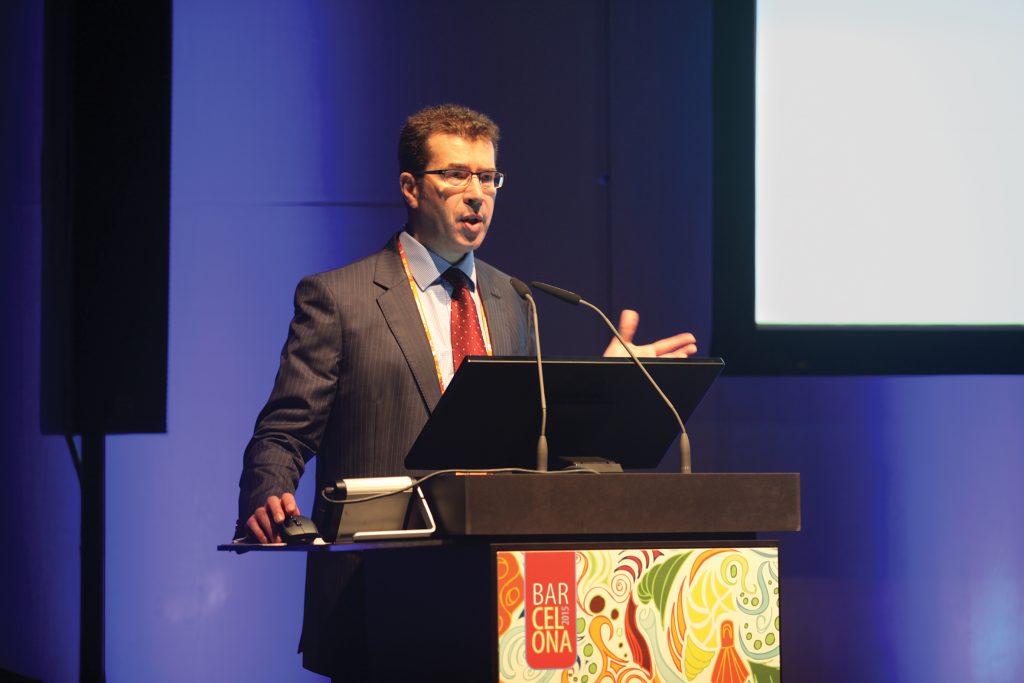Glaucoma imaging
Real-life role of OCT in glaucoma care: structural imaging used as a complement to functional testing

Cheryl Guttman Krader
Published: Friday, February 1, 2019
 David Garway-Heath MD[/caption]
Although the disease-related functional loss is what matters to patients with glaucoma, because of the variability that can occur with measurements of function, complementary information from structural imaging with OCT is useful for resolving uncertainty that can arise when using visual field test results to diagnose glaucoma and monitor for progression, said David Garway-Heath, MD.
Speaking at Glaucoma Day during the annual ESCRS Congress in Vienna, Dr Garway-Heath noted, however, that the diagnostic precision of OCT is also not perfect. He described a systematic approach for reviewing the OCT report and emphasised the importance of considering the information in the context of clinical parameters.
“The take-home message is that machines don’t have brains. You do, and you have to use your intelligence when interpreting the printouts,” said Dr Garway-Heath, IGA Professor of Ophthalmology, University College London, London, England.
The first step in the systematic approach is to check the retinal nerve fibre layer (RNFL) segmentation in the scan to assess image quality.
“If image quality is poor, there can be erroneous segmentation in the image and therefore erroneous analysis by the software,” he said.
Once segmentation errors and artefacts are ruled out, the next step is to look for the region of RNFL thinning in the en face and thickness maps and to compare it with the circle scan. Next, clinicians should look for topographical correspondence between the RNFL thinning and visual field sensitivity loss. In addition, they should look for macula damage, especially in the macula vulnerability zone that is especially susceptible to developing loss in early glaucoma, and then check for correspondence between the macula and RNFL maps.
“The key is to be cross-checking all of the time for concordance between findings,” Dr Garway-Heath.
Discussing the use of OCT to monitor for glaucomatous progression, Dr Garway-Heath explained that its performance relative to functional testing depends on stage of disease. He reviewed findings from a study showing that OCT was more likely than visual field testing to detect progression in eyes with early glaucoma. The performance of the two methods was similar when the baseline mean deviation was about -10dB. Functional testing was more likely to detect progression in eyes with more advanced disease.
“Realise that neither structural imaging or visual field testing is 100% accurate, and so both methods need to be used across the disease spectrum to increase the likelihood of identifying progression if it is occurring,” Dr Garway-Heath said.
David Garway-Heath MD[/caption]
Although the disease-related functional loss is what matters to patients with glaucoma, because of the variability that can occur with measurements of function, complementary information from structural imaging with OCT is useful for resolving uncertainty that can arise when using visual field test results to diagnose glaucoma and monitor for progression, said David Garway-Heath, MD.
Speaking at Glaucoma Day during the annual ESCRS Congress in Vienna, Dr Garway-Heath noted, however, that the diagnostic precision of OCT is also not perfect. He described a systematic approach for reviewing the OCT report and emphasised the importance of considering the information in the context of clinical parameters.
“The take-home message is that machines don’t have brains. You do, and you have to use your intelligence when interpreting the printouts,” said Dr Garway-Heath, IGA Professor of Ophthalmology, University College London, London, England.
The first step in the systematic approach is to check the retinal nerve fibre layer (RNFL) segmentation in the scan to assess image quality.
“If image quality is poor, there can be erroneous segmentation in the image and therefore erroneous analysis by the software,” he said.
Once segmentation errors and artefacts are ruled out, the next step is to look for the region of RNFL thinning in the en face and thickness maps and to compare it with the circle scan. Next, clinicians should look for topographical correspondence between the RNFL thinning and visual field sensitivity loss. In addition, they should look for macula damage, especially in the macula vulnerability zone that is especially susceptible to developing loss in early glaucoma, and then check for correspondence between the macula and RNFL maps.
“The key is to be cross-checking all of the time for concordance between findings,” Dr Garway-Heath.
Discussing the use of OCT to monitor for glaucomatous progression, Dr Garway-Heath explained that its performance relative to functional testing depends on stage of disease. He reviewed findings from a study showing that OCT was more likely than visual field testing to detect progression in eyes with early glaucoma. The performance of the two methods was similar when the baseline mean deviation was about -10dB. Functional testing was more likely to detect progression in eyes with more advanced disease.
“Realise that neither structural imaging or visual field testing is 100% accurate, and so both methods need to be used across the disease spectrum to increase the likelihood of identifying progression if it is occurring,” Dr Garway-Heath said.